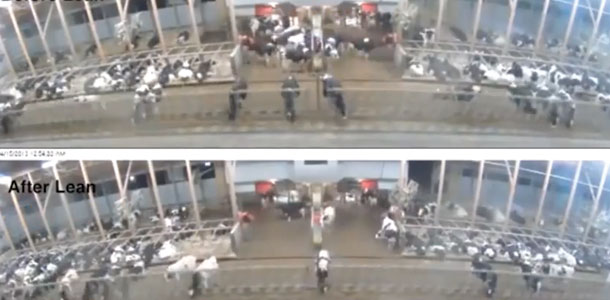Robot customer Mike Haines’ point of view is one many robotic dairy producers share: “I didn’t put these things in because I have money. I put them in to have a life,” Mike says. Mike and his wife, Heather, co-own and operate Haines Dairy – a 175-cow operation – with their young family in Sigourney, Iowa. They transitioned to robotic milking in 2013, eager to take advantage of the flexibility robotic milking boasted to spend more time with their family.
As with any dairy producer, the robots were a serious investment intended to earn their keep. After a year’s time, the couple was extremely frustrated because they were still fetching 20 to 30 cows per day. “At that point, we seriously thought about going back to milking in the parlor because it seemed to take us longer to fetch cows on a daily basis than to milk in the parlor,” Mike says.
Luckily, the Haines family decided to reach out to the manufacturer before completely writing off their three robots. On a phone call where the couple was ready to throw in the towel, Heather described the issue: “The robots aren’t working; cows just don’t want to go in on their own,” she said.
A webinar to troubleshoot the issue led to a personal visit from me. “After the webinar, Gaylen came and spent about three to four hours on the farm with us. After discussing and observing what was happening, he said: ‘You guys just need to get out of the barn.’
He told us to push up any remaining cows that hadn’t been milked and then to hold each other accountable to stay out of the barn until the next morning.” Almost 12 hours later, the couple, both skeptical that much had changed, was shocked to check their herd management software to find only five cows needed to be fetched.
Within 24 hours of the owners’ new routine, they went to their son’s double-header ball game, ate lunch together, did a few chores and went fishing together as a family. The victory won was best described by Heather’s comment that day, “I feel free!”
Today, the Haines family is happy to report their daily high fetch list is a thing of the past. “A week ago, we were down to one fetch cow out of 175 cows, and it took less than 10 minutes to fetch her. The fetch list increases when the new heifers come through, but once they learn, they figure it out pretty quick,” Mike says.
So where were the Haineses going wrong with their daily herd activities and what tools helped to sniff out the problem for a quick and satisfying solution? Just as cows are trained to milk in a parlor, this herd became accustomed to Mike or Heather taking turns to push them toward the robot. In a way, many of the cows became trained to be fetched rather than coached to visit the robot freely, as intended.
This is a common problem for many producers who transition to robotic milking because the old parlor mentality makes pushing or fetching cows an instinctive move. Through observing the barn with cows in their natural state, with no one getting in their way, it was easy to pinpoint the issue.
To further confirm the problem was a result of too much human activity in the barn, the Haineses were asked (at the time of on-farm consultation) which hours of the day they suspected their robots were most efficient.
They guessed 8 a.m. to 10 p.m. because that was when they were around the barn able to fetch cows if needed. A default graph showing milkings per hour on the herd management software indicated the robots were most efficient around 10:30 p.m., after the couple turned in for the night.
Robotic milking producers who find themselves in a situation similar to Haines Dairy should evaluate current people routines and standard operating procedures (SOPs) on the farm to find ways to minimize time in the cow pens.
While robotic milking also boasts increased individual herd management, that doesn’t necessarily mean producers should spend more one-on-one time with Ol’ Bessie in her pen. It means the individual cow data to efficiently manage each cow’s health, reproduction and production is available to only hop in the pen when it is really necessary.
One can learn a lot by observing. Maybe there are several pen tasks currently strung out throughout the day that could be condensed into one to two pen visits to prevent cow flow disruption.
This type of exercise, followed by an evaluation of employees’ SOPs, can truly contribute to a far leaner and more efficient operation. And the best part of all this? While cows go their own way (to milk in the robot), the producer gets to play (or spend his or her time on improved herd management). PD
Gaylen Guyer is a Lely senior farm management support adviser. For more information on robotic milking successes, contact Gaylen by email.

Avoid the clog
Oftentimes, we see robot dairies getting disappointing results because people are in the way of the cows just when the cows wanted to visit the robot themselves. As a result, they get too-low milkings, too many fetch cows, lacking production and lacking robot output.
The video titled Lean Dairy XL Pen Routine shows cow behavior of the same pen of cows in two parallel shots before and after implementing better pen routines.
You will see in the top half of the video that cows clog up in front of the two robots many times during the day, blocking off access for the timid cows. In the bottom half, you will see that there is continuous flow of cows walking in and out of the robot without other cows being in the way.
The reason for this open access is a different pen routine. In the top situation, the herdsman is in the pen almost every hour to fetch cows, later on to scrape crossovers, an hour later again to clean the stalls and then for breeding, etc. So his frequent presence in the pen is stirring up cows over and over again, frustrating cow flow.
The better pen routine is a short, condensed routine whereby the herdsman comes into the pen and wakes up fetch cows (who will then go themselves) and during the same round cleans stalls, crossovers and water troughs – and then stays out of the pen for eight to 12 hours before coming back. Isn’t this a much easier way for man and cow to work together and be productive?






